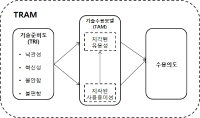
The current study was aimed to examine acceptance intention of sports Wearable products using the Technology Readiness and Acceptance Model. Data were drawn from 271 consumers in their 20s and 30s. Data were analyzed through frequency analysis, exploratory factor analysis, confirmatory factor analysis, reliability analysis, correlation analysis, simple regression analysis and multiple regression analysis using SPSS 20.0 and AMOS 20.0 program. The results were as follows: First, optimism had a positive effect on perceived usefulness but innovativeness, discomfort and insecurity did not affect perceived usefulness. Second, optimism and innovativeness had a positive effect on perceived ease of use and discomfort had a negative effect on perceived ease of use but insecurity did not affect perceived ease of use. Third, perceived ease of use had a positive effect on perceived usefulness. Fourth, perceived usefulness and perceived ease of use had a positive effect on acceptance intention.

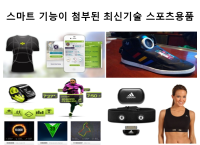

[Purpose] The purpose of this study was to examine acceptance intentions of Sports O2O Service Potential consumers using the revised model of goal-directed behavior. [Methods] The 330 surveys were distributed to potential consumers through convenience sampling method for pilot study. Due to the reliability of data, 42 samples were discarded and 288 samples were put to actual analysis. Then data were analyzed for frequency analysis, reliability analysis, correlation analysis and structural equation modeling technique via SPSS 23.0 and AMOS 22.0. [Results] The results of this study were as follows. First, attitude and subjective norm had a positive effect on desire. Second, perceived behavior control did not affect on desire but had a positive affect on acceptance intention. Third, positive anticipated emotions had a positive effect on desire but negative anticipated emotions did not effect on desire. Fourth, desire had a effect on acceptance intention. [Conclusions] According to the result, sports O2O service operators should do best to improve consumers positive attitude. Especially, they have to establish marketing strategies of introducing strong aspects of sports O2O services. Also, providing easy processes and intuitive interface are needed to consumers. To promote sports O2O services to potential consumers which is unfamiliar to that services, it is important to induce easy ways for potential consumers to experience sports O2O services.



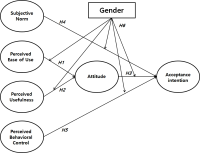
Purpose The current study was aimed to examine acceptance intention of sports wearable smart device using the Technology Acceptance Model and Theory of Planned Behavior. Methods Data were drawn from 357 consumers who had experience purchasing sports products. Data were analyzed through frequency analysis, reliability analysis, confirmatory factor analysis, correlation analysis, and structural equation modeling using SPSS 20.0 and AMOS 20.0 program. Results First, perceived ease of use had a positive effect on attitude. Second, perceived usefulness had a positive effect on attitude. Third, attitude had a positive effect on acceptance intention. Fourth, subjective norm had a positive effect on acceptance intention. Fifth, perceived behavioral control did not affect acceptance intention. Sixth, differences of path coefficients between attitude and acceptance intention, subjective norm and acceptance intention were significant according to gender. Conclusion The significance of this research is to provide the basis of positioning strategy for domestic companies of sports wearable smart device.


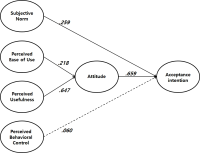

Purpose The purpose of this study was to conduct the impact of technology acceptance model(TAM) in sports field using a meta-analysis. Methods First of all, findings from 22 articles were used to analyze the relationship between perceived usefulness, perceived ease of use and intention to use via the comprehensive meta analysis(CMA) program. Results Its study results are as follows: First, results showed that TAM have a big effect on intention to use, with an effect size of .537. Second, the most influential effect size of TAM sub-factors was perceived usefulness. Third, in application and SNS had a most effect on TAM. Lastly, results found significant moderating evidence for ratio of female. But ratio of 20’s was not founded significant moderating evidence. Conclusion Based on the results of this study, it will be possible to pursue the behavior of the audience in the field where TAM is applicable in sports field.


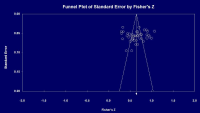


PURPOSE This study aimed to explore the structural relationships between technology-related factors and the intention to use baseball data, drawing upon the Unified Theory of Acceptance and Use of Technology (UTAUT) and technology readiness (TR). METHODS Survey data from 203 Korean professional baseball players were used in frequency, reliability, correlation, and confirmatory factor analyses as well as structural equation modeling. RESULTS Positive TR positively influenced performance expectancy, effort expectancy, social influence, and conditions facilitating baseball data use. Negative TR did not significantly impact performance expectancy, effort expectancy, social influence, and conditions facilitating baseball data use. Performance expectancy, effort expectancy, and facilitating conditions were found to positively influence data use intention, while social influence did not significantly impact data use intention. CONCLUSIONS The findings suggest that increasing performance expectancy, effort expectancy, and facilitating condition factors could be key to enhancing the intention to utilize baseball data.
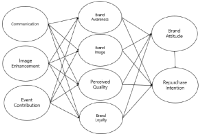
Purpose The purpose of this study was to provide title sponsorship marketing strategies by defining the relationship between professional volleyball title sponsorship, brand equity, brand attitude, and repurchase intention. Methods This study distributed 390 questionnaires to 2018-2019 V-League audiences and a total of 313 questionnaires were used as final validity sample. For data analysis, SPSS 21.0 and Amos 18.0 were used for frequency analysis, reliability analysis, confirmatory factor analysis, and structural equation analysis. Results First, title sponsorship had significant influence on brand equity, therefore hypothesis 1~3 were accepted, except for 1-3(perceived quality) and 1-4(brand loyalty). Second, among brand equity subfactors, hypothesis 4-1(brand awareness) and 4-4(brand loyalty) had significant influence on brand attitude which made hypothesis 4 partially accepted . Third, among brand equity subfactors, only brand image(hypothesis 5-2) had significant influence on repurchase intention which made hypothesis 5 partially accepted. Lastly, brand attitude had significant influence on repurchase intension, which made hypothesis 6 accepted. Conclusions It is anticipated that based on the result of the study, effective marketing strategy can be developed for title sponsorship companies in the future.

PURPOSE The purpose of this study was to analyze the effect size of the unified theory of acceptance and use of technology (UTAUT) in the sports field using a meta-analysis. METHODS After identifying related studies by using RISS, 22 articles were selected and used to analyze the relationship between UTAUT sub-factors (performance expectancy [PE], effort expectancy [EE], social influence [SI], and facilitating conditions [FC]) and intention to use via the comprehensive meta-analysis program. RESULTS The results are as follows: First, the effect size between PE and intention to use was 0.521. Second, the effect size between FC and intention to use was 0.514. Third, the effect size between EE and intention to use was 0.500. Finally, the effect size between SI and intention to use was 0.475. CONCLUSIONS Diverse strategies can be derived to increase consumers' intention to use in the sports field using the UTAUT model.
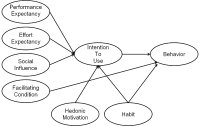
Purpose The purpose of this study was to investigate the factor that influence the using behavior of online sport media by university students applying Unified theory of acceptance and use of technology 2(UTAUT 2). Methods The study performed a research survey using convenient sampling method. The sample was 235 university students who had experience with online sport media. The data were analyzed through frequency analysis, reliability analysis, correlation analysis, confirmatory factor analysis, and structural equation model using SPSS Windows ver . 20.0 and AMOS 20.0. Results The results showed that, firstly, performance expectancy and effort expectancy had a positive effect on intention to use, however, no significant influence on social effect on intention to use. Secondly, facilitating condition had positive effect on usage behavior. Thirdly, hedonic motivation had positive effect on intention to use. Fourthly, Habit had positive effect on the intention to use and usage behavior. Lastly, intention to use had positive effect on usage behavior. Conclusion Based on the conclusion of this study, online sports media companies should provide useful and convenient viewing experience by providing personalized services, and should apply various attraction strategies to habitually use sports online media.

PURPOSE This study aimed (1) to analyze the behavioral intention and use behavior among the consumers of online home training contents via YouTube by employing the unified theory of acceptance and use of technology (UTAUT); (2) to test the moderating effects of risk perception toward the coronavirus (COVID-19) infection, and 3) to test differential impacts of generational difference across millennial and baby boom generations. METHODS A total of 400 questionnaires were distributed, and 383 samples were used for the final analysis after excluding 17 incomplete responses. Data were analyzed using the SPSS 25.0 and AMOS 22.0. RESULTS It was found that (1) the performance expectancy, the effort expectancy, and the social influence had positive effects on behavioral intention; (2)the facilitating condition had negative effects on the use behavior; (3) the behavioral intention had positive impact on the use behavior. Moreover, the risk perception toward the COVID-19 infection did not have moderating impacts on the UTAUT model, whereas generational differences did. CONCLUSIONS Our results suggest that the marketing strategy that improves exercise performance, convenience, and social influencing factors may be key to home training customers' behavioral intention and use behavior. Furthermore, home training material makers should recognize that the features and infrastructure required for the two generations are distinct and develop a separate marketing strategy for each.
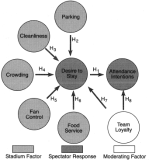
This study employed a sportscape model to analyze environmental impact on spectators’behavior. In addition, the loyalty construct in the sportscape model was reanalyzed based on the theoretical framework. Five hundred questionnaires were distributed to the spectators of World University Taekwondo Championship, and 418 questionnaires were used for data analyses. The analyses of measurement and structural models were conducted using SPSS 18.0 and EQS 6.2 programs. The results indicated that the measurement model showed acceptable reliability and validity. The structural analysis showed that five stadium factors (parking, cleanliness, crowding, food service, and fan control) have significant effects on spectators’ desire to stay and to revisit the stadium. Loyalty also positively affected revisit intention. This study emphasizes sport environment to make spectators revisit and provides future research suggestions to improve the sportscape model.


